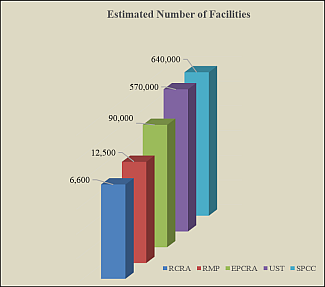Office of Land and Emergency Management (OLEM) Accomplishment Reports and Benefits
The Office of Land and Emergency Management (OLEM) in partnership with other federal agencies, states, tribes, local governments, and communities strives to preserve land and clean up communities to create a safer environment for all Americans.
On this page:
- By Protecting Human Health & the Environment
- By Leveraging Economic Opportunities and Jobs
- By Working Towards a Sustainable Future
- OLEM Programs Address Contamination at Sites Near 53 Percent of the U.S. Population
- OLEM and its Partners Oversee Approximately 640,000 to 1,319,100 Facilities to Prevent Releases into Communities
By Protecting Human Health & the Environment
- Superfund (SF) Cleanup Improves Infant Health Exit: Superfund cleanups reduces the incidence of congenital anomalies in infants of mothers living within 2 km of a site, by roughly 20 percent to 25 percent.
- Underground Storage Tanks (UST) Prevention Program Protects Groundwater: Strong UST prevention programs have decreased confirmed releases at sites by almost 16 percent over the last six years; helping to protect groundwater – the source of drinking water for nearly half of the US.
- Responding to Emergencies: Every year, more than 30,000 emergencies involving the release (or threatened release) of oil and hazardous substances are reported in the United States. EPA works with other federal agencies, state and local responders to eliminate danger to the public.
By Leveraging Economic Opportunities and Jobs
- Cleanup Increases Housing Property Values: Peer reviewed studies have found that residential properties near Superfund and brownfields sites increased in value by:
- Increases Local Tax Revenue: Analyzing data near 48 brownfields, we find an estimated $29 to $73 million in additional tax revenue for local governments in a single year after cleanup—2 to 6 times more than the $12.4 million EPA contributed to the cleanup of those brownfields.
- Creates Reuse Opportunities and Jobs:
- Brownfields has leveraged more than 106,000 jobs and $23.3 billion in cleanup and redevelopment. An average of 7.3 jobs is leveraged per $100,000 of EPA funds expended.
- At 450 Superfund sites with reuse occurring, operating businesses are employing 89,000 people and generating annual sales of $31 billion—almost 4 times the $8.2 billion (inflation adjusted) EPA has spent cumulatively at these sites.
- The Resource Conservation and Recovery Act (RCRA) Keeps America’s Economy Competitive (PDF) (105 pp, 1.4 MB, About PDF) Exit: The diversion of one ton of waste from landfills pays $101 more in salaries and wages, produces $275 more in goods and services, and generates $135 more in sales.
By Working Towards a Sustainable Future
- Sustainable Materials Management (SMM) Reduces Greenhouse Gases (GHGs): EPA estimates that SMM stakeholders’ activities in 2013 reduced greenhouse gas emissions by more than 40 million metric tons of carbon dioxide equivalents (MMTCO2E) — providing over $1.6 billion in benefits to society by reducing damages from climate change.
OLEM Programs Address Contamination at Sites Near 53 Percent of the U.S. Population
OLEM and its Partners Oversee Approximately 640,000 to 1,319,100 Facilities to Prevent Releases into Communities
- RCRA’s Permitting Program Protects 62.5 Million People: EPA and state programs oversee and manage permits for 20,000 hazardous waste units at 6,600 facilities to protect the approximately 62.5 million people living within 3 miles of these facilities.
- Risk Management Plan (RMP) Program Protects Communities Located Near 12,500 RMP Facilities: These facilities contain the largest stockpiles of highly toxic and flammable chemicals in the U.S and report on average about 253 incidents a year resulting in deaths, injuries or significant property damage.
- Emergency Planning and Community Right-to-Know Act (EPCRA) Program Assists Communities in Emergency Planning for Over 90,000 EPCRA Facilities: OLEM provides guidance to state and local response organizations in developing emergency response plans for hazardous substances at facilities in more than 3,000 local emergency planning districts.
- UST Standards Prevent Potentially Dangerous and Costly Releases at 580,000 USTs: EPA sets standards for approximately 580,000 USTs found in communities across the US.
- Spill Prevention, Control and Countermeasure Plans (SPCC) Rule Helps Prevent Oil Spills at Over 640,000 Facilities: Approximately 4,400 of these facilities are required to have a Facility Response Plan because a discharge of oil could cause substantial harm to the environment.


